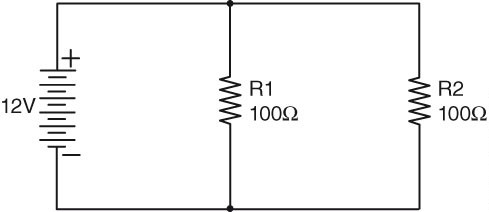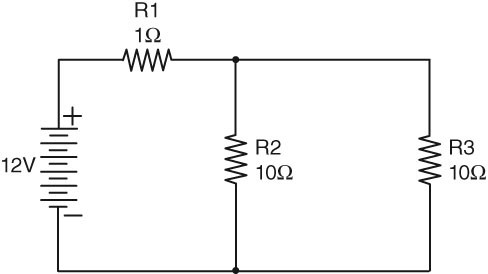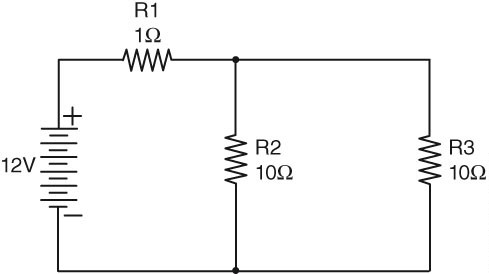Deck 2: The Fundamentals of Electricity
Question
Question
Question
Question
Question
Question
Question
Question
Question
Question
Question
Question
Question
Question
Question
Question
Question
Question
Question
Question

Unlock Deck
Sign up to unlock the cards in this deck!
Unlock Deck
Unlock Deck
1/20
Play
Full screen (f)
Deck 2: The Fundamentals of Electricity
1
Protons are attracted to other protons and repel electrons.
False
2
An atom must always have an equal number of protons and electrons.
False
3
Copper is a good conductor of electric current because it has eight or more electrons in its valence band.
False
4
Increasing the voltage causes the electric current flowing through a fixed value of resistance to increase.

Unlock Deck
Unlock for access to all 20 flashcards in this deck.
Unlock Deck
k this deck
5
Increasing the resistance while keeping the voltage source held at a fixed value causes the electric current flowing through the resistance to decrease.

Unlock Deck
Unlock for access to all 20 flashcards in this deck.
Unlock Deck
k this deck
6
Voltage is most like which of the following:
A) Restriction
B) Pressure
C) Flow rate
D) Temperature
A) Restriction
B) Pressure
C) Flow rate
D) Temperature

Unlock Deck
Unlock for access to all 20 flashcards in this deck.
Unlock Deck
k this deck
7
Technician A says that an ohmmeter can be used to measure voltage drop. Technician B says that an ammeter can be used to measure current. Who is correct?
A) A only
B) B only
C) Both A and B
D) Neither A nor B
A) A only
B) B only
C) Both A and B
D) Neither A nor B

Unlock Deck
Unlock for access to all 20 flashcards in this deck.
Unlock Deck
k this deck
8
Which is most like electric current?
A) Restriction
B) Pressure
C) Flow rate
D) Temperature
A) Restriction
B) Pressure
C) Flow rate
D) Temperature

Unlock Deck
Unlock for access to all 20 flashcards in this deck.
Unlock Deck
k this deck
9
Technician A says that the conventional theory describes electric current flow from negative to positive. Technician B says that current is measured in units of amperes per second. Who is correct?
A) A only
B) B only
C) Both A and B
D) Neither A nor B
A) A only
B) B only
C) Both A and B
D) Neither A nor B

Unlock Deck
Unlock for access to all 20 flashcards in this deck.
Unlock Deck
k this deck
10
Which is the correct equation for Ohm's law?
A) Voltage/Resistance = Current
B) Current × Resistance = Voltage
C) Voltage/Current = Resistance
D) All of the above are valid expressions of Ohm's law.
A) Voltage/Resistance = Current
B) Current × Resistance = Voltage
C) Voltage/Current = Resistance
D) All of the above are valid expressions of Ohm's law.

Unlock Deck
Unlock for access to all 20 flashcards in this deck.
Unlock Deck
k this deck
11
Which of the following is the largest value of pressure measured at sea level?
A) 14.7 psi absolute (101 kPa absolute)
B) 14.7 psi gauge (101 kPa gauge)
C) -14.7 psi absolute (-101 kPa absolute)
D) All of the above are the same value of pressure.
A) 14.7 psi absolute (101 kPa absolute)
B) 14.7 psi gauge (101 kPa gauge)
C) -14.7 psi absolute (-101 kPa absolute)
D) All of the above are the same value of pressure.

Unlock Deck
Unlock for access to all 20 flashcards in this deck.
Unlock Deck
k this deck
12
A voltmeter that is being used to measure a voltage drop across a resistor is most like which of the following?
A) A differential pressure gauge measuring the pressure drop across a hydraulic circuit restriction
B) A flow meter measuring the rate of hydraulic fluid flow
C) Two pressure gauges measuring the pressure in a hydraulic circuit referenced to atmospheric pressure
D) An ohmmeter measuring the resistance in an electric circuit with current flowing through the circuit
A) A differential pressure gauge measuring the pressure drop across a hydraulic circuit restriction
B) A flow meter measuring the rate of hydraulic fluid flow
C) Two pressure gauges measuring the pressure in a hydraulic circuit referenced to atmospheric pressure
D) An ohmmeter measuring the resistance in an electric circuit with current flowing through the circuit

Unlock Deck
Unlock for access to all 20 flashcards in this deck.
Unlock Deck
k this deck
13
Referring to the following circuit, technician A says that 12V would be dropped across R1 and R2. Technician B says that the same amount of current will flow through R1 and R2. Who is correct?

A) A only
B) B only
C) Both A and B
D) Neither A nor B

A) A only
B) B only
C) Both A and B
D) Neither A nor B

Unlock Deck
Unlock for access to all 20 flashcards in this deck.
Unlock Deck
k this deck
14
Which of the following is a true statement regarding the circuit shown below?

A) The amount of current flow through R1 is equal to the current flow through R2 added to the current flow through R3.
B) The voltage dropped across R2 is the same as the voltage dropped across R3.
C) The voltage dropped across R2 added to the voltage dropped across R1 is equal to 12V.
D) All of the above are true statements.

A) The amount of current flow through R1 is equal to the current flow through R2 added to the current flow through R3.
B) The voltage dropped across R2 is the same as the voltage dropped across R3.
C) The voltage dropped across R2 added to the voltage dropped across R1 is equal to 12V.
D) All of the above are true statements.

Unlock Deck
Unlock for access to all 20 flashcards in this deck.
Unlock Deck
k this deck
15
What is the total resistance of the circuit shown below?

A) 11 ohms
B) 21 ohms
C) 6 ohms
D) 12V x the total current

A) 11 ohms
B) 21 ohms
C) 6 ohms
D) 12V x the total current

Unlock Deck
Unlock for access to all 20 flashcards in this deck.
Unlock Deck
k this deck
16
Which is a correct statement with regard to the circuit shown below?

A) Electricity always takes the path of least resistance; therefore no current will flow through R1.
B) The same amount of electric current will flow through R1 and R2.
C) If R2 were removed from the circuit, the amount of current flow through R1 would remain unchanged.
D) The voltage dropped across R2 is much less than the voltage dropped across R1.

A) Electricity always takes the path of least resistance; therefore no current will flow through R1.
B) The same amount of electric current will flow through R1 and R2.
C) If R2 were removed from the circuit, the amount of current flow through R1 would remain unchanged.
D) The voltage dropped across R2 is much less than the voltage dropped across R1.

Unlock Deck
Unlock for access to all 20 flashcards in this deck.
Unlock Deck
k this deck
17
Referring to the following circuit, which resistor has the highest voltage dropped across it?

A) R1
B) R2
C) Both R1 and R2 have the same voltage drop.
D) Neither resistor will have a voltage drop since no current will flow in this circuit.

A) R1
B) R2
C) Both R1 and R2 have the same voltage drop.
D) Neither resistor will have a voltage drop since no current will flow in this circuit.

Unlock Deck
Unlock for access to all 20 flashcards in this deck.
Unlock Deck
k this deck
18
Which best describes the reason that a circuit breaker or fuse may interrupt electric current if someone is using too many household devices at the same time such as a hair dryer, microwave oven, and toaster?
A) The devices are all connected in series and each device that is switched on adds an additional series resistance.
B) The devices are all connected in parallel and each device that is switched on decreases the total circuit resistance causing the total circuit current to increase.
C) The circuit breaker or fuse has too small of a rating.
D) The electric company limits the amount of current supplied to a house.
A) The devices are all connected in series and each device that is switched on adds an additional series resistance.
B) The devices are all connected in parallel and each device that is switched on decreases the total circuit resistance causing the total circuit current to increase.
C) The circuit breaker or fuse has too small of a rating.
D) The electric company limits the amount of current supplied to a house.

Unlock Deck
Unlock for access to all 20 flashcards in this deck.
Unlock Deck
k this deck
19
A technician measures 10A using a clamp-on inductive ammeter placed around the battery positive cable on a truck with the ignition on and engine off. He also measures 10A with the inductive ammeter placed around the battery negative cable. Which best explains the reason for these measurements?
A) Kirchhoff's voltage law
B) Ohm's law
C) Kirchhoff's current law
D) The rules of series-parallel circuits
A) Kirchhoff's voltage law
B) Ohm's law
C) Kirchhoff's current law
D) The rules of series-parallel circuits

Unlock Deck
Unlock for access to all 20 flashcards in this deck.
Unlock Deck
k this deck
20
Which of the following is the largest value of resistance?
A) The total resistance of two 1k ohm resistors connected in series
B) The total resistance of two 1k ohm resistors connected in parallel
C) 1000 ohms
D) 100,000 milliohms
A) The total resistance of two 1k ohm resistors connected in series
B) The total resistance of two 1k ohm resistors connected in parallel
C) 1000 ohms
D) 100,000 milliohms

Unlock Deck
Unlock for access to all 20 flashcards in this deck.
Unlock Deck
k this deck



